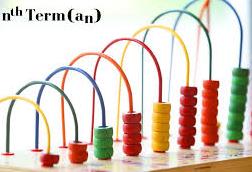Arithmetic series, also known as the arithmetic progression is a progression obtained by adding the terms of the arithmetic sequence.
The arithmetic sequence a, a+d, a+2d, a+3d+…….+a+(n-1)d….becomes a+(a+d)+(a+2d)+(a+3d)+………….+[a+(n-1)d].
Just like the arithmetic sequence, the first term of the arithmetic progression(A.P) is a and the common difference is d while nth term is a+(n-1)d.

sum of Arithmetic series
We use the Sn to denote the sum of the first n terms in series.
s1 is equivalent to the first term of the sequence.
s2 is the sum of the first two terms in the series.
s3 is the sum of the first three terms of the sequence.
consider the sequence: 5, 9, 13, 17, 21, 25, 29, 33, 37, 41, 45, 49, 53, 57, 61,……..
the first term of the series will be 5.
s1 = 5
s2 = 5+9 = 14
s3 = 5+9+13 = 27
s4 = 5+9+13+17 = 44
let us add the first 10 terms of the series
s10 = 5+9+13+17+21+25+29+33+37+41 = 230
we can start summing from the last term to the first term as shown:
s10 =41+37+33+29+25+21+17 +13+9+5= 230
let us arrange the two sums vertically to each other and add
s10 = 5+ 9+13+17+21+25+29+33+37+41= 230
s10 =41+37+33+29+25+21+17+13+ 9+ 5= 230
-------------------------------------------
2s10 = 46+46+46+46+46+46+46+46+46+46 = 460
-------------------------------------------
2s10 = 46 x10
this means that :
from the above expression, it looks like we could easily get the summation of n numbers of items in an arithmetic series by simply adding two terms vertically. When arranged in reverse order, multiply by n then divide by two to get the sum.
From the above observations, we can easily add the the last term and the first term multiply by number of terms to get the sum x 2.
in other words; if there there are n terms in a series, if we have a term in m position, then am+a[n-(m-1)] = will always give the same value.
in the above series, let mth b the 7th term, then [n-(m-1)]th will be (10-7)th term = 3rd term.
consider the series s10 =5+9+13+17+21+25+29+33+37+41= 230
The 7th term = 29 while [n-(m-1)]th = [10-(7-1)]th term = [10-6]th term = 4th term.
The term in the series will be equal to 17.
29+17 = 46
To have a general expression, let us consider the general arithmetic series:
General expression of arithmetic series
sn = a+(a+d)+(a+2d)+(a+3d)+……..+[a+(n-3)d][a+(n-2)d]+[a+(n-1)d]
sn=a+(a+d)+(a+2d)+(a+3d)+.....+[a+(n-2)d]+[a+(n-1)d]
sn=[a+(n-1)d]+[a+(n-2)d]+ ....+(a+3d)+(a+2d)+(a+d)+a
-------------------------------------------------
2sn = n[a+a+(n-1)d)]=n[2a+(n-1)d]
2sn = n[2a+(n-1)d]
therefore, the general expression for the sum of n terms of an arithmetic series can be given by:
using the formula to sum arithmetic series
As an example, consider the series:
5+9+13+17+21+25+29+33+37+41

